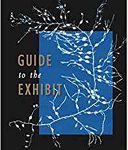 Lisa Allen Ortiz
Lisa Allen Ortiz
Guide to the Exhibit
Perugia Press
Reviewer: Lee Rossi
In Guide to the Exhibit, Lisa Allen Ortiz offers the reader a tour of her own personal museum of natural (and unnatural) history, the product of a lifetime’s devoted collecting. Filled with wonders—birds abound but also mastodons and minerals, gemstones and microfossils—the book is a meditation on collecting, the kind that museums do as well as the kind done by desperate people. Collecting, like memory, is an act of defiance in the face of loss. It may also be an act of despair. Ortiz, “a single docent heart at her waxy desk of ribs” (“The Self Museum”), does not flinch from examining the emotional consequences of loss.
A good docent, as we know, studies her subject with an intensity utterly foreign to the casual museumgoer. And yet she might have a covert motive, to awaken in listeners the same passionate devotion to her subject that motivates her. Ortiz attempts that and even more, no mere knowledge transfer, but an education in life and feeling. As she notes in “Parkinson’s Disease, Late Stage Ghazal,” what she offers is “a field guide to sorrow.” The sorrows are various—the extinction of plants and animals, the loss of loved ones to dementia—but the response is ruthlessly clear-eyed and unsentimental.
In “Patois,” for instance, we encounter a woman who, “when she spoke, birds came out of her mouth,” and for whom “mass extinction became…a personal affront.” “Her vocabulary,” we are told, “contracted by 200 feathered words a day.” If nothing else, the poet reminds us that our knowledge of the world shrinks as quickly as we destroy it. In the end, the woman grows “quiet as a tree” and dies in silence. We (her friends, her children) “texted our regrets. / We pen-scratched bits on paper and threw them toward her grave.” What else can the poet do, but scratch her poems, each poem an elegy for Mother Earth?
Who is this woman, so affronted? She is like the “Assistant to the Curator,” who has created “a world unbalanced by so much keeping.” Or like the barista in “Identification,” tasking herself with memorizing the names of all the plants she sees in her daily life: “Alum Root, Apache Plum…Bad Dog, Balloon Flower.” Knowledge is power, they say, but for the barista such knowledge obscures the simple joy which first impelled her to learn these names. “She’s grown blind with sight,” the poet tells us. What can she do? Pray, says the poet, pray for that seldom-experienced grace in which knowledge and joy flow effortlessly into one another: “Let the wind. Let the light. Let her sweater / lift from her shoulders like—petals / of a Flannel Bush, a Gambleweed, a Fiddleneck.”
Grace is transitory, and what it leaves behind is as often anger as peace. We see this anger at work in “The Animal Dictionary”:
We’ve named them all and still they slink around.
They fight and fornicate and eat each other raw.
They claw and snarl and mark the world with piss.
Still we pick up beef or salmon and toss it on the grill.
There is an end-stopped fury here with echoes far beyond the end of each line. And even though we recognize that her comment applies as much to human as to non-human animals, the speaker’s vision of the natural world is almost medieval.
It’s no surprise then, that given her sensitivity to loss and the sharpness of her disappointment, this narrator would be attracted to suicide. “Suicide Forest,” for instance, finds the poet spelunking in the darkness of the self. Without telling us why, she tells us, “I didn’t want to light the lamps again. / Fatal life, I thought, leave me in the dark.” In this Stygian dark, she is haunted by cold rock and ropes, by bodies hanging and buried. The voices of her daughters are the only things that keep her attached to life. “The world is tame and sweet! I howled,” declaring with her scream that the world is anything but tame and sweet. Together with her daughters she improvises a waltz, “step, step, step…in the sooty glass,” until her body returns to her, “tin lantern in her hand.”
Despite this collection’s comprehensive darkness, we experience a delicacy of language and insight which often transforms it. In “Hummingbird Study” she calls a sketch of a hummingbird “carbon tenderness,” invoking not just the power of art but the healing virtues of nature. This tension—between poetry and darkness—is a one of the book’s characteristic features.
At times, the darkness threatens to overwhelm the poet and the poetry. “Animus,” for instance, is a perverse nocturne, a love poem that almost syllogistically speaks of the emptying out of the self as required by love, and then of the nothing that remains once love disappears:
Think how foolish we are—who wake up
and remember!
We should spend every day forgetting,
leaving behind what will surely be taken.
Whatever its initial impact, eventually love will dry up, disappear. As she tells her lover: “Love, the moon is dead too— / but sticks around.”
There is consolation here, but only of the most desperate kind.
Smallness is a recurring theme, an analog for the speaker’s shrunken sense of self, as well for other losses; wilderness, for example, and indigenous peoples. In “Grief,” dedicated to a Pomo Indian girl, she declares, “Oh eyelash forest. Oh teardrop moon. / Close my eyes and let me see.” See what, we may ask? Those vanished lives and places? If such recovery is possible, it comes at the price of closing one’s eyes to one’s own life and immediate reality.
Winner of the Perugia Prize, awarded each year to a woman at the beginning of her publishing career, Guide to the Exhibit, with its focus on the small and transient, may be Ortiz’s first book, but it shows promise of larger wonders to come. Like a collection of microfossils, her book is “A universe made of marks…wanting to be handled, seen, and noted.” Given the incisiveness of her observations and the grace of her writing, I trust it will be much handled and long noted.

